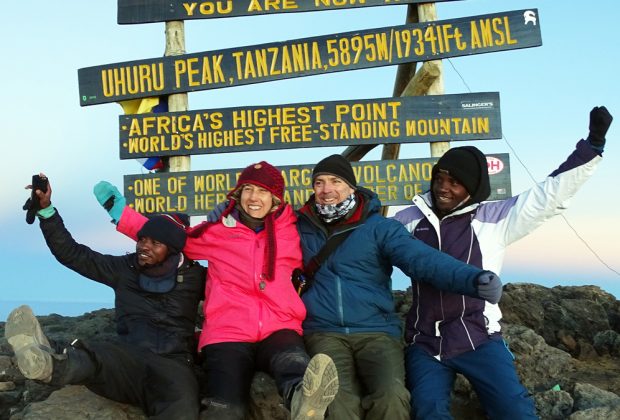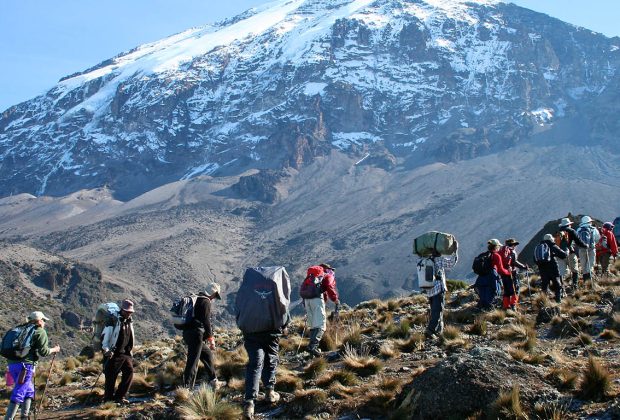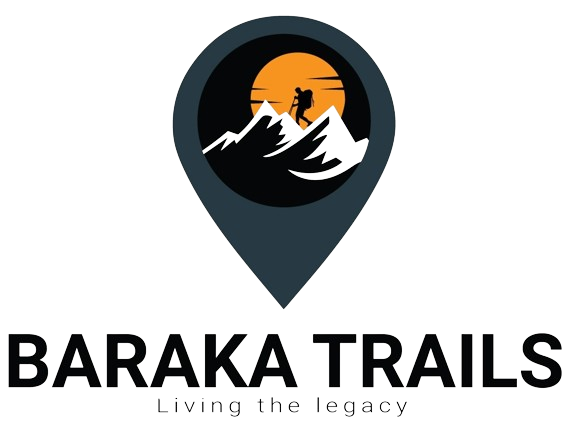Kilimanjaro Training



Kilimanjaro training
Training to climb Mount Kilimanjaro requires preparation both physically and mentally. Here’s a general outline of what your training might look like:
Cardiovascular Fitness: Since Kilimanjaro is a strenuous trek, cardiovascular endurance is crucial. Activities like running, cycling, swimming, or using the stair climber can help build your endurance. Aim for at least 30-60 minutes of cardio exercise most days of the week.
Strength Training: Strengthening your legs, core, and upper body can help you endure the long days of hiking and carry your backpack. Incorporate exercises like squats, lunges, deadlifts, planks, and push-ups into your routine.
Hiking: Nothing prepares you better for hiking than… hiking! Try to simulate the conditions you’ll encounter on Kilimanjaro by hiking on trails with varied terrain, increasing the distance and elevation gain gradually over time.
Altitude Acclimatization: While training at sea level won’t replicate the altitude of Kilimanjaro, you can still improve your body’s ability to acclimatize by gradually increasing your exposure to higher elevations. If possible, plan shorter hikes at higher altitudes leading up to your Kilimanjaro climb.
Endurance: Building endurance is key. Plan longer hikes on weekends or whenever you have time. Start with a distance you’re comfortable with and gradually increase it over time.
Mental Preparation: Climbing Kilimanjaro can be mentally challenging, especially during tough moments on the mountain. Practice mental resilience techniques such as visualization, mindfulness, and positive self-talk to help you push through when things get tough.
Gear Familiarization: Get comfortable with your hiking gear, especially your boots, backpack, and clothing layers. Make sure everything fits well and that you’re familiar with how to use it.
Hydration and Nutrition: Pay attention to your hydration and nutrition needs during training. Practice eating and drinking what you plan to consume on the mountain to ensure it agrees with you and provides the necessary energy.
Remember to listen to your body during training and adjust your routine as needed. And most importantly, enjoy the journey!
What Kind of Hikes Should I Do to Train?
Training hikes for Kilimanjaro should simulate the conditions you’ll encounter on the mountain as closely as possible. Here are some suggestions:
Long, Steady Hikes: Focus on building endurance with long hikes. Start with hikes of moderate difficulty and gradually increase both the distance and elevation gain over time. Aim for hikes that last several hours to simulate the duration of a typical day on Kilimanjaro.
Elevation Gain: Kilimanjaro involves significant elevation gain, so incorporate hikes with uphill sections to build strength and endurance. Look for trails with a variety of terrain, including steep inclines.
Variable Terrain: Kilimanjaro’s terrain varies from rocky paths to loose scree, so train on trails with similar conditions. Seek out hikes that include rocky sections, loose gravel, and uneven terrain to prepare your muscles and balance for the challenges ahead.
High Altitude Hikes (if possible): If you have access to high altitude trails, incorporate them into your training regimen to acclimatize your body to reduced oxygen levels. Hiking at higher altitudes can help prepare you for the altitude on Kilimanjaro, even if you don’t live in a high-altitude area.
Backpacking Practice: If you plan to carry a backpack on Kilimanjaro, train with it during your hikes. Gradually increase the weight of your pack to simulate the gear and supplies you’ll be carrying on the mountain.
Multi-Day Hikes: If possible, plan multi-day hiking trips to simulate the consecutive days of hiking you’ll experience on Kilimanjaro. This will help you gauge your stamina and recovery between hiking days.
Night Hikes: Some parts of the Kilimanjaro trek, particularly the summit push, may be done in the dark. Consider doing some of your training hikes at night to get comfortable hiking with a headlamp and navigating in low-light conditions.
Downhill Hikes: Don’t overlook downhill hiking in your training. Descending steep slopes can be tough on your knees and muscles, so include hikes with significant downhill sections to prepare your body for the descent on Kilimanjaro.
Test Your Gear While Training
Testing your gear during training hikes is crucial for ensuring that everything works well and that you’re comfortable with it before tackling Kilimanjaro. Here’s how you can incorporate gear testing into your training:
Boots: Wear your hiking boots on training hikes to break them in and ensure they’re comfortable. Test them on various types of terrain to make sure they provide the support and traction you need.
Backpack: Use your backpack during training hikes to get a feel for how it carries weight and whether it fits comfortably. Pack it with the gear and supplies you plan to take on Kilimanjaro to gauge its capacity and organization.
Clothing Layers: Test your clothing system during training hikes to ensure you’re comfortable and adequately protected from the elements. Experiment with different layering combinations to find what works best for various weather conditions.
Sleeping Gear: If you’ll be camping on Kilimanjaro, test your sleeping bag, sleeping pad, and tent during overnight backpacking trips. Make sure your sleep system keeps you warm and comfortable in different temperatures.
Trekking Poles: If you plan to use trekking poles on Kilimanjaro, incorporate them into your training hikes to get comfortable with their use and adjust the length to suit different terrain.
Headlamp: Test your headlamp during night hikes to ensure it provides adequate illumination and that you’re familiar with its settings and battery life.
Hydration System: Use your hydration bladder or water bottles during training hikes to stay hydrated and ensure they’re leak-proof and easy to access.
Food and Snacks: Experiment with different types of snacks and energy foods during training hikes to find what works best for sustaining your energy levels during long days of hiking.
Navigation Tools: Practice using your map, compass, or GPS device during training hikes to improve your navigation skills and ensure you can find your way on Kilimanjaro if needed.
Emergency Gear: Carry essential emergency gear such as a first aid kit, emergency shelter, and communication device during training hikes to ensure you’re prepared for unexpected situations.
By testing your gear during training hikes, you’ll identify any issues or discomforts early on and have the opportunity to make adjustments before embarking on your Kilimanjaro climb.
